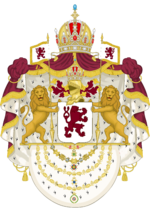Rudolphine Confederation
Rudolphine Confederation Eidgenossenschaft | |||||||
|---|---|---|---|---|---|---|---|
| 1027-1786 | |||||||
 The Rudolphine Confederation at its greatest extent prior to the Amendist Wars in 1582. | |||||||
| Capital | No single/fixed capital (1027-1640) Westbrücken (1640-1786) de jure Wiesstadt (1640-1786) de facto | ||||||
| Common languages | Official: Weranian and Medieval Solarian | ||||||
| Religion | Official: Catholicism (1106-1607) | ||||||
| Government | Confederal elective monarchy (1027-1664) Confederal absolute monarchy (1664-1785) Confederal constitutional monarchy (1785-1786) | ||||||
| Rudolphine Protector | |||||||
• 1027-1051 (first) | Rudolf I | ||||||
• 1764-1785 (last) | Leopold III | ||||||
| Legislature | Reichsrat | ||||||
| Historical era | Middle Ages Early modern period | ||||||
• Established | 1027 | ||||||
• Disestablished | 1786 | ||||||
| Population | |||||||
• 1582 | ~8,000,000 | ||||||
• 1786 | ~20,000,000 | ||||||
| |||||||
The Rudolphine Confederation (Weranian: Eidgenossenschaft) was a historical confederation that ruled over much of north Euclea from its declaration in 1027 to the Weranian Revolution when it was replaced by the Republic of Werania in 1786. At its height it spanned across the entirity of modern day Werania, Azmara and Alsland as well as southern Scovern, northern Estmere and eastern Kirenia.
The confederation was formed in 1027 by the princes of northern Weraninland to contest the Estmero-Verliquoian invasion of modern-day Borland. The confederation changed over time from a predominantly pagan to mainly Catholic body. It would retain a rivalry with the Kingdom of Ruttland until the latter became part of the confederation in the Union of Trierberg in 1267 with the Ruttish King Wilhelm I becoming protector of the confederation. By the 1480s however power had shifted to the Cislanian House of Schwarzollen who would dominate the confederation from that point on.
Historically a decentralised entity the confederation was torn apart by the Amendist Reaction which led to the Amendist Wars. Following the wars the confederations leaders attempted to centralise the realm abolishing many noble privileges but this alienated many of its members. The Ten Years' War saw the confederation devastated and it entered a steep decline resulting in the Weranian revolution in 1785, which saw the confederation remoulded into the Weranian Republic a year later.
The confederation slowly evolved from being a purely military alliance to by its demise in 1785 a modern, centralised state. It tends to be perceived as a precursor to the modern Weranian state although its legacy affects all its former neighbours. During its existence it was informally referred to by its citizens as the Reich.
Name
History
Blattenberg dynasty
Formation
Turn to Sotirianity
Algirdas Dynasty
Schwarzollen dynasty
Zenith
Amendist split
Golden liberty
Absolutism
Decline
Demise
Institutions and governance
The Rudolphine Confederation during its existence slowly developed from a loose series of bilateral alliances to a semi-centralised absolutist state. The confederation was for the majority of its existence governed by kings, bishops, dukes and others who theoretically elected the head of the confederacy, the protector (Reichsprotektor). Over the lifetime of the confederacy there were periods both of greater power being given to the constituent princedoms (as occurred during the late 1500s) and greater centralisation at their expense (as occurred a century later in the 1670s).
The initial Eidgenossenschaft (“oath commonwealth”) was similar in theory to the leagues of cities (Städtebünde) that often arouse in northern Euclea. These alliances were often led by a ruler who would act as a military commander with the purpose of defeating external threats by rallying together large armies. Notably these leagues were often created through bilateral treaties and so often had overlapping interests between their members who even occassionally went to war with each other. The early Eidgenossenschaft of Rudolph I was distinguished by being geographically far larger than these previous leagues with Rudolf I having ambitions to centralise it into a single entity akin to the Verliquoian Empire. Although this failed to develop Rudolf I was able in 1044 convince the member princes to sign the Charter of Vorausdorf that officially declared the Eidgenossenschaft to be an “unbreakable” alliance of the founding princes. Notably the Vorausdorf Charter enshrined the principle that forbade a member from unilaterally beginning a war without the consent of the protector of the confederacy. The protector could in the event of war raise taxes on members and request a certain amount of troops under his command.
Over time saw the development of other entities. Beginning in the 1400s the protector appointed a chief minister, the chancellor (Reichskanzler) to administer the affairs of state replacing the previous custom of relying on the state officials from the protectors home kingdom. Following the Amendist Wars a federal diet, the Reichsrat, was created which had representatives from each of the member states leading to a period known as “golden liberty”. However the absolutist reforms of Otto IX ended this period with the rights of the nobility severely curtailed. This absolutist form of governance was almost brought to collapse during the Ten Years' War with the confederation subsequently reconvening the an albeit weakened Reichstag whilst maintaining the centralisation of power. The Weranian Revolution would briefly see the confederation become a constitutional monarchy with a premier (minister-president) replacing the chancellor and an elected legislature, the National Convention (Nationalkonvent).



